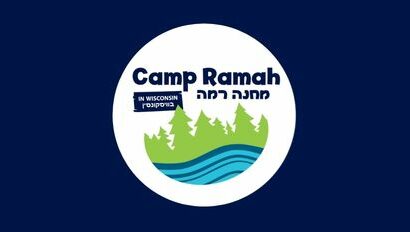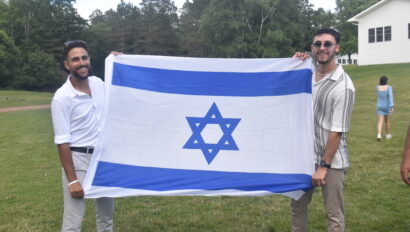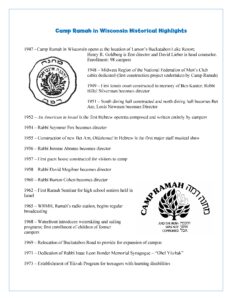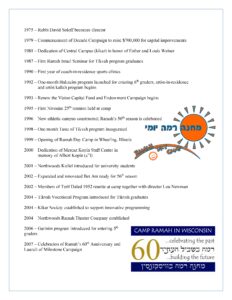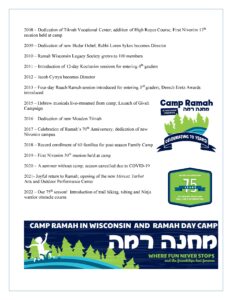Thank you to
- Mickey Azizullahoff-Komar and Racheli Komar-Azizullahoff from the Madison, WI, Jewish Federation, and their family
- Todd Clauer from Hyman Brand Hebrew Academy in Overland Park, KS, and his family
- Rabbi Nate Crane from Congregation B’nai Tikvah in Deerfield, IL, and his family
- Amy Skopp Cooper, National Ramah Associate Director
- Ali Drumm and Sam Eisenstein from North Suburban Synagogue Beth El in Highland Park, IL
- Ethan Helfand from EMTZA Region USY
- Gita Karasov and Tali Ribnick from the Hillel at the University of Michigan
- Dr. Mitch Kupperman from JCamp180
- Rachel Ripps from the American Hebrew Academy
- Rabbi Michael Schwab from North Suburban Synagogue Beth El in Highland Park, IL, and his family
- Rabbi Michael Siegel from Anshe Emet Synagogue in Chicago, IL, and his family
for joining us for a visit this week!
Last Saturday night into Sunday, we commemorated the fast of Tisha B’av, the 9th day of the Hebrew month of Av, when Jews around the world observe a day of national mourning for various tragedies that have befallen our people through the millennia. On Tisha B’av we recite Megillat Eichah (the Book of Lamentations), which we read liturgically as a series of elegiac poems written in the wake of the destruction of the First Temple in Jerusalem by the Babylonians on Tisha B’av in 586 B.C.E. The first verse of Eichah begins:
In the first years of Camp Ramah in Wisconsin, there was a contest to write the camp’s anthem. A young staff member named Moshe Greenberg penned the winning entry, a gorgeous poem rife with layered allusions to classical Jewish texts that we still sing today and that continues to inspire and provide direction for our work here. Rabbi Dr. Greenberg (ז”ל) would go on to be arguably the greatest scholar of the Hebrew Bible of the second half of the Twentieth Century, a giant whose students and writings continue to reap rewards even after his passing a few years ago. In the first verse of המנון רמה (Himnon Ramah, the Ramah anthem), Greenberg wrote:
Greenberg parallels Ramah to the desolate Jerusalem – why? I believe he was making a wry commentary made all the more powerful by an inverted metaphor. He knew that every summer Tisha B’av falls during the summer and that nearly every year campers and staff would read Eichah as they spent time at Ramah. Writing in the years after the horrors of the Holocaust had first been uncovered, he must have appreciated the irony of his usage of badad, the Hebrew word for alone or desolate. In Eichah, Jerusalem is described as empty and disconnected, a world capital devoid of its ties to other cities and bereft of its “spouse,” the Jewish people. At Ramah, filled with the vibrancy of a renaissance in Jewish life, camp is filled up with joy and song, yet our geographic isolation (even more so in the late ‘40s and early ‘50s than today) allowed for him to use the same word. Camp Ramah, for Greenberg, would serve as the phoenix rising from the ashes; but it would do so in isolation. Our apartness was – and is – essential to the power and efficacy of our mission.
As part of my graduate studies, a number of years ago I read Leslie Paris’sChildren’s Nature: The Rise of the American Summer Camp. In tracing the origins of the institution familiar to us all today, Paris notes that the first camps, opened in the final decades of the 1800s, were created to provide children with something they could not receive at home. In an increasingly urban America, the smog and heat of the cities led to “open-air” camps, and in increasingly technologically sophisticated America there were concerns among many that children – especially boys – would suffer from a lack of connection with nature.
Nearly 150 years into summer camping, we continue to justify ourselves similarly: why schlep so far to Camp Ramah? What are the benefits of being so badad? This week at camp was filled with examples of the power of our disconnectedness, of that crucial part of our magical recipe that Greenberg highlighted for us.
Every year I am pleasantly surprised when we get to the end of Eichah and begin one of the Kinot (songs of mourning). As the entire camp seems to join in singing from the first or second note, I marvel at the transmission of knowledge at Ramah from one generation to another, a knowledge that testifies to our camper’s embrace of a rather arcane piece of Jewish ritual, one that will nonetheless carry them successfully to future Tisha B’avs they choose to experience in any corner of the Jewish world.
The separateness of summer camps has also enabled them to be an incubator for social change movements. Sitting apart from the general culture, summer camp plays a countercultural role for our campers and staff. In every generation that role manifests itself differently, and it is no coincidence that many innovations in the Jewish world over the last hundred years began in summer camps, including early support of Zionism and the State of Israel, a commitment to speaking Hebrew, the move towards more congregational singing, egalitarianism, social justice causes, and civil rights. I was reminded of this three times last night. First, during one of the most moving scenes in recent camp history, Nivonim’s (11th graders) performance of Hairspray in Hebrew, scenes of civil rights protests from Baltimore and elsewhere were projected on a screen behind the singers. While the projection began with familiar scenes from the context of Hairspray, in the 1950s and 1960s, they eventually came into visual dialogue with scenes from the traumatic racial moments of the last year. Later, we heard from two groups of Bogrim (9th graders) campers: one had spent a week with expert outdoor educator Josh Lake connecting with and discovering the magic of our natural surroundings, while the second created a moving performance about social change and where we get our food and the costs of food waste. Finally, the Rosh Aidah (division head) for Machon (10th graders) recounted powerful experiences from Machon’s recent trip through Wisconsin where they volunteered at a not-for-profit farm that provides food for the roughly 25% of children who live in the city of Milwaukee who go hungry. Later in the trip they had the impromptu opportunity to interview several Jewish members of a baseball team that plays in a regional league populated mostly with Division I college players. The players’ responses about Jewish peoplehood and identity both highlighted the different cultural norms for them than for our Ramah campers and the profound ties that bind all of us together as Jews.
Camp Ramah dwells apart in Conover, WI, for a reason. Our “aloneness” allows our community to grow even closer, and for the impact of our counselors, adult staff, and special guests to be magnified. Whether we are learning how to observe and enact our Judaism, developing our own sense of ourselves as Jews, or learning social and independent-living skills, each of us takes advantage of the uniqueness of our surroundings. Where else can we learn to live with other peers in a communal cabin we are responsible for cleaning? Where else can we disconnect from our cellphones and Facebook accounts? Where else can we challenge gender roles in our society, to resist and reframe messages about interpersonal behavior, appearance, and wealth?
Yesterday afternoon I witnessed an amazing basketball game between theSolelim (7th grade) and Shoafim (8th grade) young women. As the entire aidotgathered around center court, boys and girls, the girls on their respective teams gave us a game for the ages. At a high level, the two evenly matched teams entertained a growing crowd that witnessed an eventual Shoafim victory by three points. As we continue to work on promoting a healthy place for both genders at camp, this type of game – played at a high level and with meaningful cross-gender and multi-aged communal support – could not have happened at Ramah even a few years ago. In many of our communities at home, we would also struggle to find this level of communal buy-in for girls’ sports.
I could go on and on with these stories, each their own gems of what happens here on a daily basis, in this place that an esteemed colleague coined during a visit this week as “the most incredibly intentional educational playground” she knows. That phrase is a great compliment to our senior leadership team and lay leadership that shoulder so much of the responsibility for creating that intentionality, making it possible to dream big, and then implementing our vision. At the same time, so much of what that colleague witnessed was actually notintentional, at least not directly. We set up an intentional structure here that, each and every summer, as a testament to our staff and campers, takes on a life of its own. We set the parameters and we help infuse the system with stimuli and ideas. And yet, when things are truly working, the machine seems to run itself, energy building on energy.
As we enter the last week of camp, I feel compelled to share not just the beginning brilliance of a young Moshe Greenberg’s understanding of Ramah – that we would be effective precisely because we dwell at a remove from our surroundings. In the third and final verse of our camp anthem, which we sang last night after the Nivonim play, Greenberg combines two Biblical idioms to express the full-flowered vision of Ramah’s impact on the world. An institution designed to be apart from the broader world, a nearly-closed laboratory for creating mentsches, Jews, professionals, and Americans, would also be destined to perform miracles for the world. He concluded the anthem:
Borrowing a word we are most familiar with from the “signs and wonders” that God did for the Children of Israel in Egypt – mofeit, and a phrase from the blessing given to our matriarch Rebecca as she leaves her home to marry, that she would represent, or produce, numbers beyond count, Greenberg makes clear that the essence of Ramah, it’s physical loneliness, would be contrasted with thedestiny we know to be true: our success can only be judged by what those who dwell apart for each summer do with the rest of their year, and with the rest of their lives.
May the holy work that our campers are part of for the summer spill over into their lives at home, and into the world in which we all live.
Shabbat Shalom, Jacob
Suggested questions to ask your camper early next week via e-mail: Halutzim: What did you learn about yourself or your aidah mates during “Where’s Waldo” Day? Solelim: How did “Life” Day teach you to work as a team/family? Shoafim: Which important cause did you choose to support on “Northwoodstock” Day? Bogrim: What Shavua Bogrim (Bogrim Week) clinic did you participate in? What was your favorite part of the week? Machon: What was your favorite part of the Machon trip? Tikvah: What special activities did you do this week while Machon was away from camp? Nivonim: What was your favorite part of performing Hairspray? Atzmayim: Why are résumés important?

